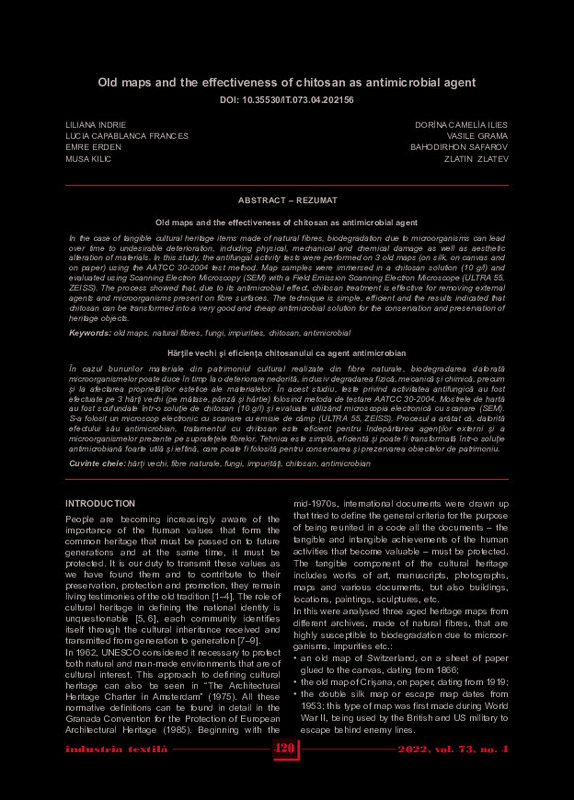JavaScript is disabled for your browser. Some features of this site may not work without it.
Buscar en RiuNet
Listar
Mi cuenta
Estadísticas
Ayuda RiuNet
Admin. UPV
Old maps and the effectiveness of chitosan as antimicrobial agent
Mostrar el registro sencillo del ítem
Ficheros en el ítem
| dc.contributor.author | Indrie, Liliana
|
es_ES |
| dc.contributor.author | Capablanca Francés, Lucía
|
es_ES |
| dc.contributor.author | Erden, Emre
|
es_ES |
| dc.contributor.author | Kilic, Musa
|
es_ES |
| dc.contributor.author | Ilies, Dorína Camelía
|
es_ES |
| dc.contributor.author | Grama, Vasile
|
es_ES |
| dc.contributor.author | Safarov, Bahodirhon
|
es_ES |
| dc.contributor.author | Zlatev, Zlatin
|
es_ES |
| dc.date.accessioned | 2024-01-12T19:02:17Z | |
| dc.date.available | 2024-01-12T19:02:17Z | |
| dc.date.issued | 2022 | es_ES |
| dc.identifier.issn | 1222-5347 | es_ES |
| dc.identifier.uri | http://hdl.handle.net/10251/201898 | |
| dc.description.abstract | [EN] In the case of tangible cultural heritage items made of natural fibres, biodegradation due to microorganisms can lead over time to undesirable deterioration, including physical, mechanical and chemical damage as well as aesthetic alteration of materials. In this study, the antifungal activity tests were performed on 3 old maps (on silk, on canvas and on paper) using the AATCC 30-2004 test method. Map samples were immersed in a chitosan solution (10 g/l) and evaluated using Scanning Electron Microscopy (SEM) with a Field Emission Scanning Electron Microscope (ULTRA 55, ZEISS). The process showed that, due to its antimicrobial effect, chitosan treatment is effective for removing external agents and microorganisms present on fibre surfaces. The technique is simple, efficient and the results indicated that chitosan can be transformed into a very good and cheap antimicrobial solution for the conservation and preservation of heritage objects. | es_ES |
| dc.description.sponsorship | The research article was produced with equal scientific involvement of all authors. We acknowledge the partially contribution of University of Oradea Grants, Competition "Scientific Research of Excellence Related to Priority Areas with Capitalization through Technology Transfer: INO-TRANSFER-UO", Projects No. 329/2021; No. 317/2021. | es_ES |
| dc.language | Inglés | es_ES |
| dc.publisher | Certex | es_ES |
| dc.relation.ispartof | Industria Textila | es_ES |
| dc.rights | Reconocimiento (by) | es_ES |
| dc.subject | Old maps | es_ES |
| dc.subject | Natural fibres | es_ES |
| dc.subject | Fungi | es_ES |
| dc.subject | Impurities | es_ES |
| dc.subject | Chitosan | es_ES |
| dc.subject | Antimicrobial | es_ES |
| dc.title | Old maps and the effectiveness of chitosan as antimicrobial agent | es_ES |
| dc.type | Artículo | es_ES |
| dc.identifier.doi | 10.35530/IT.073.04.202156 | es_ES |
| dc.relation.projectID | info:eu-repo/grantAgreement/Universitatea din Oradea//INO-TRANSFER-UO//Scientific Research of Excellence Related to Priority Areas with Capitalization through Technology Transfer/ | es_ES |
| dc.relation.projectID | info:eu-repo/grantAgreement/Universitatea din Oradea//329%2F2021/ | es_ES |
| dc.relation.projectID | info:eu-repo/grantAgreement/Universitatea din Oradea//317%2F2021/ | es_ES |
| dc.rights.accessRights | Abierto | es_ES |
| dc.description.bibliographicCitation | Indrie, L.; Capablanca Francés, L.; Erden, E.; Kilic, M.; Ilies, DC.; Grama, V.; Safarov, B.... (2022). Old maps and the effectiveness of chitosan as antimicrobial agent. Industria Textila. 73(4):420-425. https://doi.org/10.35530/IT.073.04.202156 | es_ES |
| dc.description.accrualMethod | S | es_ES |
| dc.relation.publisherversion | https://doi.org/10.35530/IT.073.04.202156 | es_ES |
| dc.description.upvformatpinicio | 420 | es_ES |
| dc.description.upvformatpfin | 425 | es_ES |
| dc.type.version | info:eu-repo/semantics/publishedVersion | es_ES |
| dc.description.volume | 73 | es_ES |
| dc.description.issue | 4 | es_ES |
| dc.relation.pasarela | S\481306 | es_ES |
| dc.contributor.funder | Universitatea din Oradea | es_ES |








